2007 ISUZU KB P190 oil
[x] Cancel search: oilPage 3422 of 6020
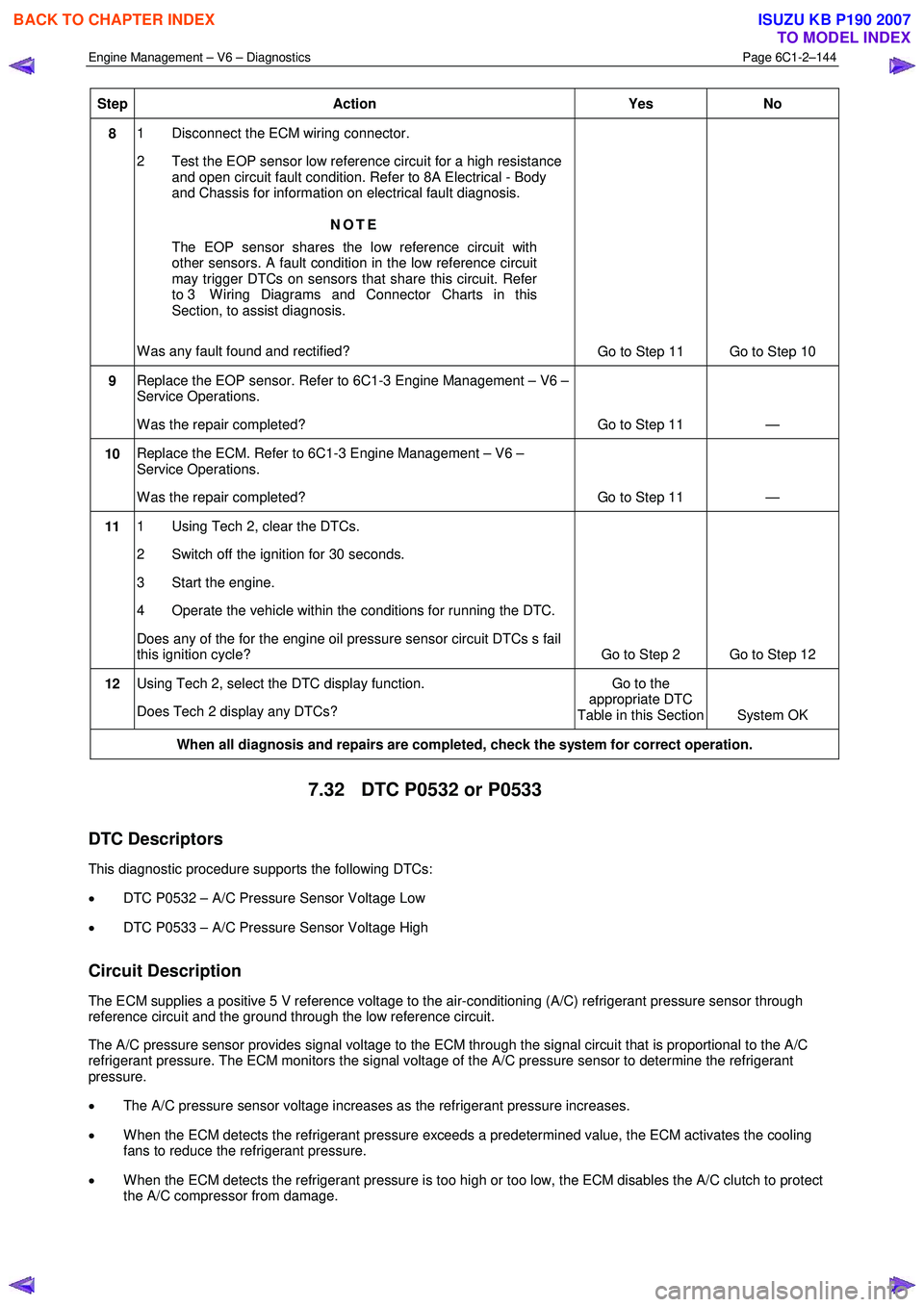
Engine Management – V6 – Diagnostics Page 6C1-2–144
Step Action
Yes No
8 1 Disconnect the ECM wiring connector.
2 Test the EOP sensor low reference circuit for a high resistance and open circuit fault condition. Refer to 8A Electrical - Body
and Chassis for information on electrical fault diagnosis.
NOTE
The EOP sensor shares the low reference circuit with
other sensors. A fault condition in the low reference circuit
may trigger DTCs on sensors that share this circuit. Refer
to 3 W iring Diagrams and Connector Charts in this
Section, to assist diagnosis.
W as any fault found and rectified? Go to Step 11 Go to Step 10
9 Replace the EOP sensor. Refer to 6C1-3 Engine Management – V6 –
Service Operations.
W as the repair completed? Go to Step 11 —
10 Replace the ECM. Refer to 6C1-3 Engine Management – V6 –
Service Operations.
W as the repair completed? Go to Step 11 —
11 1 Using Tech 2, clear the DTCs.
2 Switch off the ignition for 30 seconds.
3 Start the engine.
4 Operate the vehicle within the conditions for running the DTC.
Does any of the for the engine oil pressure sensor circuit DTCs s fail
this ignition cycle? Go to Step 2 Go to Step 12
12 Using Tech 2, select the DTC display function.
Does Tech 2 display any DTCs? Go to the
appropriate DTC
Table in this Section System OK
When all diagnosis and repairs are completed, check the system for correct operation.
7.32 DTC P0532 or P0533
DTC Descriptors
This diagnostic procedure supports the following DTCs:
• DTC P0532 – A/C Pressure Sensor Voltage Low
• DTC P0533 – A/C Pressure Sensor Voltage High
Circuit Description
The ECM supplies a positive 5 V reference voltage to the air-conditioning (A/C) refrigerant pressure sensor through
reference circuit and the ground through the low reference circuit.
The A/C pressure sensor provides signal voltage to the ECM through the signal circuit that is proportional to the A/C
refrigerant pressure. The ECM monitors the signal voltage of the A/C pressure sensor to determine the refrigerant
pressure.
• The A/C pressure sensor voltage increases as the refrigerant pressure increases.
• W hen the ECM detects the refrigerant pressure exceeds a predetermined value, the ECM activates the cooling
fans to reduce the refrigerant pressure.
• W hen the ECM detects the refrigerant pressure is too high or too low, the ECM disables the A/C clutch to protect
the A/C compressor from damage.
BACK TO CHAPTER INDEX
TO MODEL INDEX
ISUZU KB P190 2007
Page 3429 of 6020
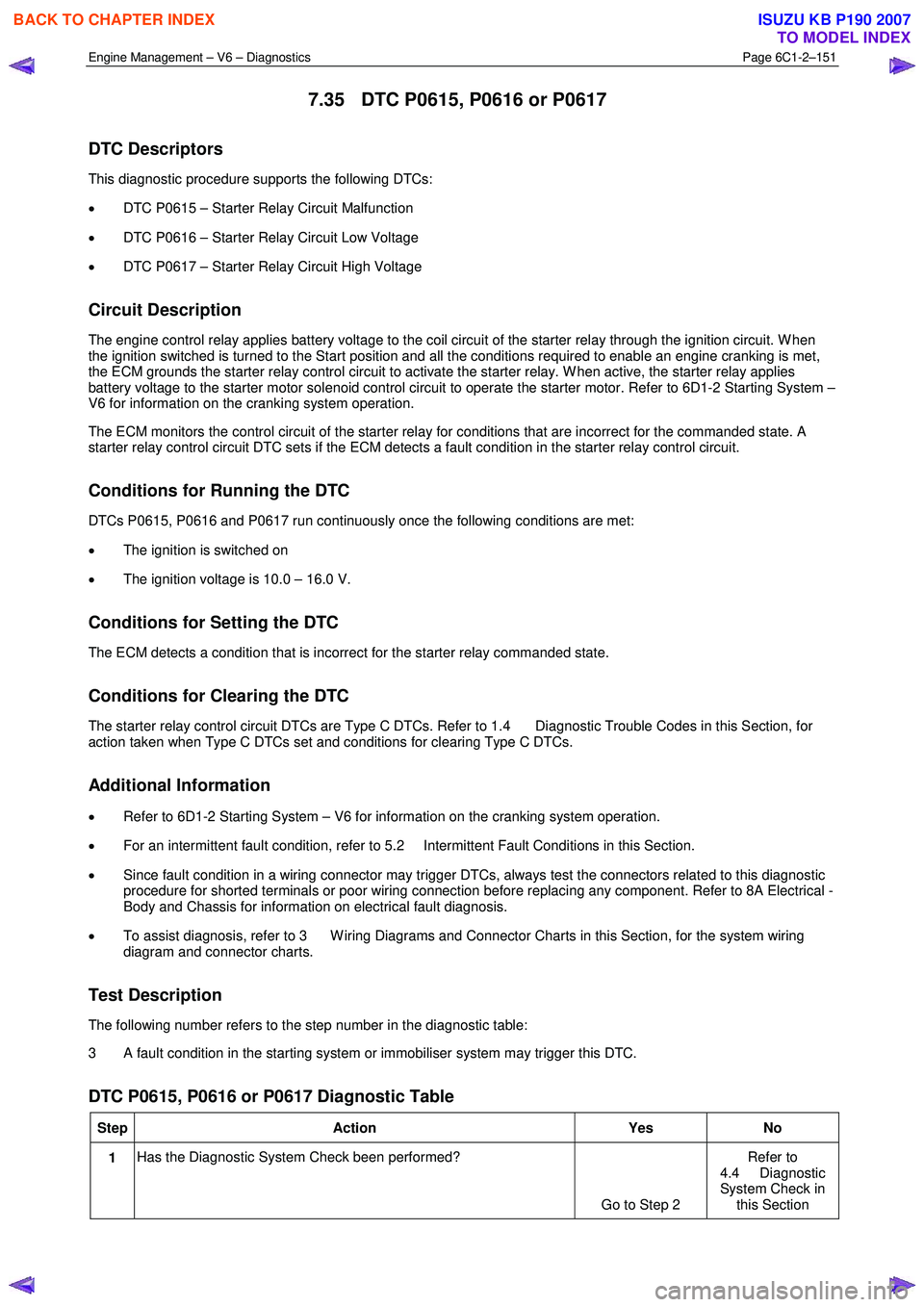
Engine Management – V6 – Diagnostics Page 6C1-2–151
7.35 DTC P0615, P0616 or P0617
DTC Descriptors
This diagnostic procedure supports the following DTCs:
• DTC P0615 – Starter Relay Circuit Malfunction
• DTC P0616 – Starter Relay Circuit Low Voltage
• DTC P0617 – Starter Relay Circuit High Voltage
Circuit Description
The engine control relay applies battery voltage to the coil circuit of the starter relay through the ignition circuit. W hen
the ignition switched is turned to the Start position and all the conditions required to enable an engine cranking is met,
the ECM grounds the starter relay control circuit to activate the starter relay. W hen active, the starter relay applies
battery voltage to the starter motor solenoid control circuit to operate the starter motor. Refer to 6D1-2 Starting System –
V6 for information on the cranking system operation.
The ECM monitors the control circuit of the starter relay for conditions that are incorrect for the commanded state. A
starter relay control circuit DTC sets if the ECM detects a fault condition in the starter relay control circuit.
Conditions for Running the DTC
DTCs P0615, P0616 and P0617 run continuously once the following conditions are met:
• The ignition is switched on
• The ignition voltage is 10.0 – 16.0 V.
Conditions for Setting the DTC
The ECM detects a condition that is incorrect for the starter relay commanded state.
Conditions for Clearing the DTC
The starter relay control circuit DTCs are Type C DTCs. Refer to 1.4 Diagnostic Trouble Codes in this Section, for
action taken when Type C DTCs set and conditions for clearing Type C DTCs.
Additional Information
• Refer to 6D1-2 Starting System – V6 for information on the cranking system operation.
• For an intermittent fault condition, refer to 5.2 Intermittent Fault Conditions in this Section.
• Since fault condition in a wiring connector may trigger DTCs, always test the connectors related to this diagnostic
procedure for shorted terminals or poor wiring connection before replacing any component. Refer to 8A Electrical -
Body and Chassis for information on electrical fault diagnosis.
• To assist diagnosis, refer to 3 W iring Diagrams and Connector Charts in this Section, for the system wiring
diagram and connector charts.
Test Description
The following number refers to the step number in the diagnostic table:
3 A fault condition in the starting system or immobiliser system may trigger this DTC.
DTC P0615, P0616 or P0617 Diagnostic Table
Step Action Yes No
1 Has the Diagnostic System Check been performed?
Go to Step 2 Refer to
4.4 Diagnostic
System Check in this Section
BACK TO CHAPTER INDEX
TO MODEL INDEX
ISUZU KB P190 2007
Page 3433 of 6020
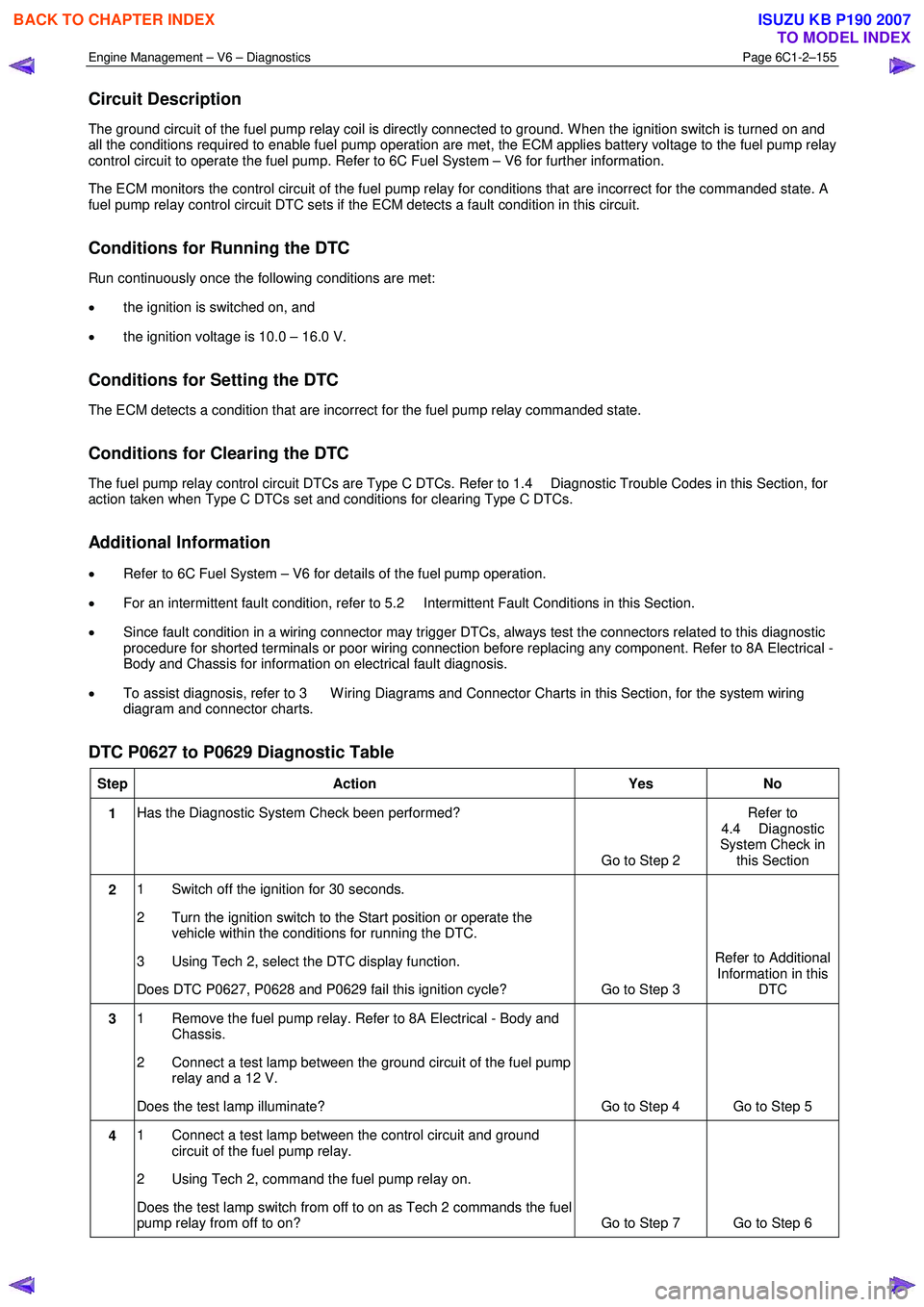
Engine Management – V6 – Diagnostics Page 6C1-2–155
Circuit Description
The ground circuit of the fuel pump relay coil is directly connected to ground. W hen the ignition switch is turned on and
all the conditions required to enable fuel pump operation are met, the ECM applies battery voltage to the fuel pump relay
control circuit to operate the fuel pump. Refer to 6C Fuel System – V6 for further information.
The ECM monitors the control circuit of the fuel pump relay for conditions that are incorrect for the commanded state. A
fuel pump relay control circuit DTC sets if the ECM detects a fault condition in this circuit.
Conditions for Running the DTC
Run continuously once the following conditions are met:
• the ignition is switched on, and
• the ignition voltage is 10.0 – 16.0 V.
Conditions for Setting the DTC
The ECM detects a condition that are incorrect for the fuel pump relay commanded state.
Conditions for Clearing the DTC
The fuel pump relay control circuit DTCs are Type C DTCs. Refer to 1.4 Diagnostic Trouble Codes in this Section, for
action taken when Type C DTCs set and conditions for clearing Type C DTCs.
Additional Information
• Refer to 6C Fuel System – V6 for details of the fuel pump operation.
• For an intermittent fault condition, refer to 5.2 Intermittent Fault Conditions in this Section.
• Since fault condition in a wiring connector may trigger DTCs, always test the connectors related to this diagnostic
procedure for shorted terminals or poor wiring connection before replacing any component. Refer to 8A Electrical -
Body and Chassis for information on electrical fault diagnosis.
• To assist diagnosis, refer to 3 W iring Diagrams and Connector Charts in this Section, for the system wiring
diagram and connector charts.
DTC P0627 to P0629 Diagnostic Table
Step Action Yes No
1 Has the Diagnostic System Check been performed?
Go to Step 2 Refer to
4.4 Diagnostic
System Check in this Section
2 1 Switch off the ignition for 30 seconds.
2 Turn the ignition switch to the Start position or operate the vehicle within the conditions for running the DTC.
3 Using Tech 2, select the DTC display function.
Does DTC P0627, P0628 and P0629 fail this ignition cycle? Go to Step 3 Refer to Additional
Information in this DTC
3 1 Remove the fuel pump relay. Refer to 8A Electrical - Body and
Chassis.
2 Connect a test lamp between the ground circuit of the fuel pump relay and a 12 V.
Does the test lamp illuminate? Go to Step 4 Go to Step 5
4 1 Connect a test lamp between the control circuit and ground
circuit of the fuel pump relay.
2 Using Tech 2, command the fuel pump relay on.
Does the test lamp switch from off to on as Tech 2 commands the fuel
pump relay from off to on? Go to Step 7 Go to Step 6
BACK TO CHAPTER INDEX
TO MODEL INDEX
ISUZU KB P190 2007
Page 3434 of 6020
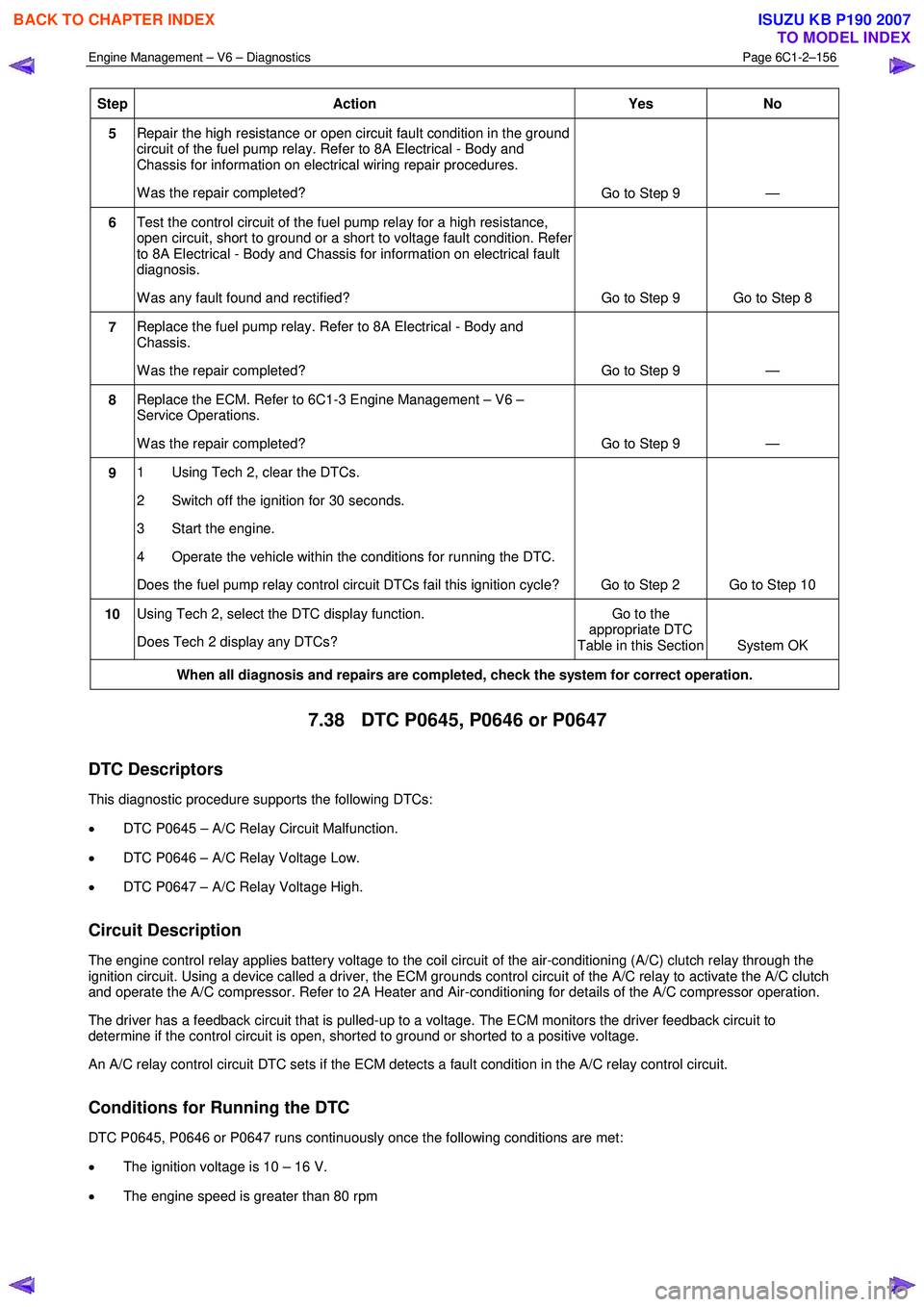
Engine Management – V6 – Diagnostics Page 6C1-2–156
Step Action Yes
No
5 Repair the high resistance or open circuit fault condition in the ground
circuit of the fuel pump relay. Refer to 8A Electrical - Body and
Chassis for information on electrical wiring repair procedures.
W as the repair completed? Go to Step 9 —
6 Test the control circuit of the fuel pump relay for a high resistance,
open circuit, short to ground or a short to voltage fault condition. Refer
to 8A Electrical - Body and Chassis for information on electrical fault
diagnosis.
W as any fault found and rectified? Go to Step 9 Go to Step 8
7 Replace the fuel pump relay. Refer to 8A Electrical - Body and
Chassis.
W as the repair completed? Go to Step 9 —
8 Replace the ECM. Refer to 6C1-3 Engine Management – V6 –
Service Operations.
W as the repair completed? Go to Step 9 —
9 1 Using Tech 2, clear the DTCs.
2 Switch off the ignition for 30 seconds.
3 Start the engine.
4 Operate the vehicle within the conditions for running the DTC.
Does the fuel pump relay control circuit DTCs fail this ignition cycle? Go to Step 2 Go to Step 10
10 Using Tech 2, select the DTC display function.
Does Tech 2 display any DTCs? Go to the
appropriate DTC
Table in this Section System OK
When all diagnosis and repairs are completed, check the system for correct operation.
7.38 DTC P0645, P0646 or P0647
DTC Descriptors
This diagnostic procedure supports the following DTCs:
• DTC P0645 – A/C Relay Circuit Malfunction.
• DTC P0646 – A/C Relay Voltage Low.
• DTC P0647 – A/C Relay Voltage High.
Circuit Description
The engine control relay applies battery voltage to the coil circuit of the air-conditioning (A/C) clutch relay through the
ignition circuit. Using a device called a driver, the ECM grounds control circuit of the A/C relay to activate the A/C clutch
and operate the A/C compressor. Refer to 2A Heater and Air-conditioning for details of the A/C compressor operation.
The driver has a feedback circuit that is pulled-up to a voltage. The ECM monitors the driver feedback circuit to
determine if the control circuit is open, shorted to ground or shorted to a positive voltage.
An A/C relay control circuit DTC sets if the ECM detects a fault condition in the A/C relay control circuit.
Conditions for Running the DTC
DTC P0645, P0646 or P0647 runs continuously once the following conditions are met:
• The ignition voltage is 10 – 16 V.
• The engine speed is greater than 80 rpm
BACK TO CHAPTER INDEX
TO MODEL INDEX
ISUZU KB P190 2007
Page 3435 of 6020
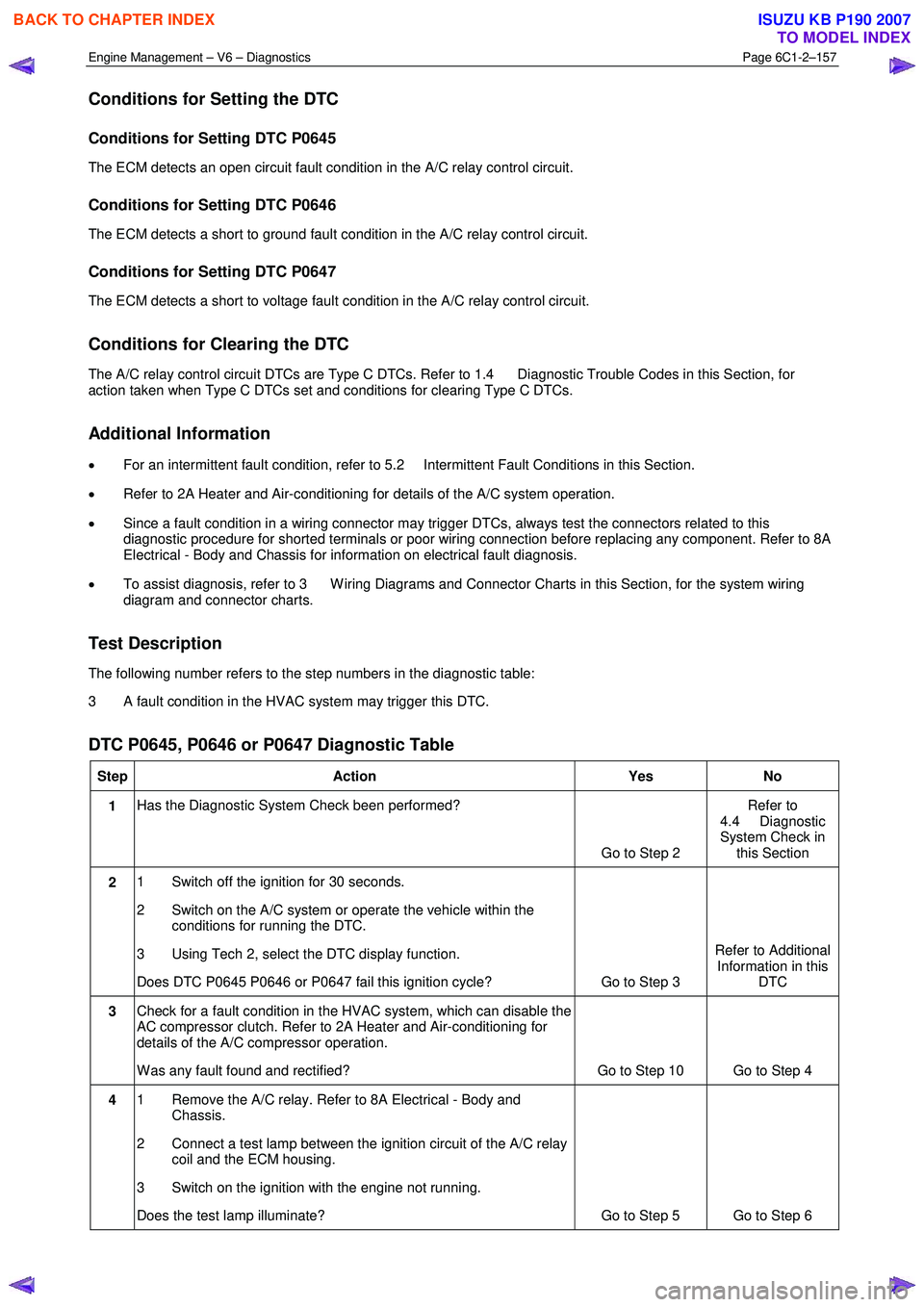
Engine Management – V6 – Diagnostics Page 6C1-2–157
Conditions for Setting the DTC
Conditions for Setting DTC P0645
The ECM detects an open circuit fault condition in the A/C relay control circuit.
Conditions for Setting DTC P0646
The ECM detects a short to ground fault condition in the A/C relay control circuit.
Conditions for Setting DTC P0647
The ECM detects a short to voltage fault condition in the A/C relay control circuit.
Conditions for Clearing the DTC
The A/C relay control circuit DTCs are Type C DTCs. Refer to 1.4 Diagnostic Trouble Codes in this Section, for
action taken when Type C DTCs set and conditions for clearing Type C DTCs.
Additional Information
• For an intermittent fault condition, refer to 5.2 Intermittent Fault Conditions in this Section.
• Refer to 2A Heater and Air-conditioning for details of the A/C system operation.
• Since a fault condition in a wiring connector may trigger DTCs, always test the connectors related to this
diagnostic procedure for shorted terminals or poor wiring connection before replacing any component. Refer to 8A
Electrical - Body and Chassis for information on electrical fault diagnosis.
• To assist diagnosis, refer to 3 W iring Diagrams and Connector Charts in this Section, for the system wiring
diagram and connector charts.
Test Description
The following number refers to the step numbers in the diagnostic table:
3 A fault condition in the HVAC system may trigger this DTC.
DTC P0645, P0646 or P0647 Diagnostic Table
Step Action Yes No
1 Has the Diagnostic System Check been performed?
Go to Step 2 Refer to
4.4 Diagnostic
System Check in this Section
2 1 Switch off the ignition for 30 seconds.
2 Switch on the A/C system or operate the vehicle within the conditions for running the DTC.
3 Using Tech 2, select the DTC display function.
Does DTC P0645 P0646 or P0647 fail this ignition cycle? Go to Step 3 Refer to Additional
Information in this DTC
3 Check for a fault condition in the HVAC system, which can disable the
AC compressor clutch. Refer to 2A Heater and Air-conditioning for
details of the A/C compressor operation.
W as any fault found and rectified? Go to Step 10 Go to Step 4
4 1 Remove the A/C relay. Refer to 8A Electrical - Body and
Chassis.
2 Connect a test lamp between the ignition circuit of the A/C relay coil and the ECM housing.
3 Switch on the ignition with the engine not running.
Does the test lamp illuminate? Go to Step 5 Go to Step 6
BACK TO CHAPTER INDEX
TO MODEL INDEX
ISUZU KB P190 2007
Page 3463 of 6020
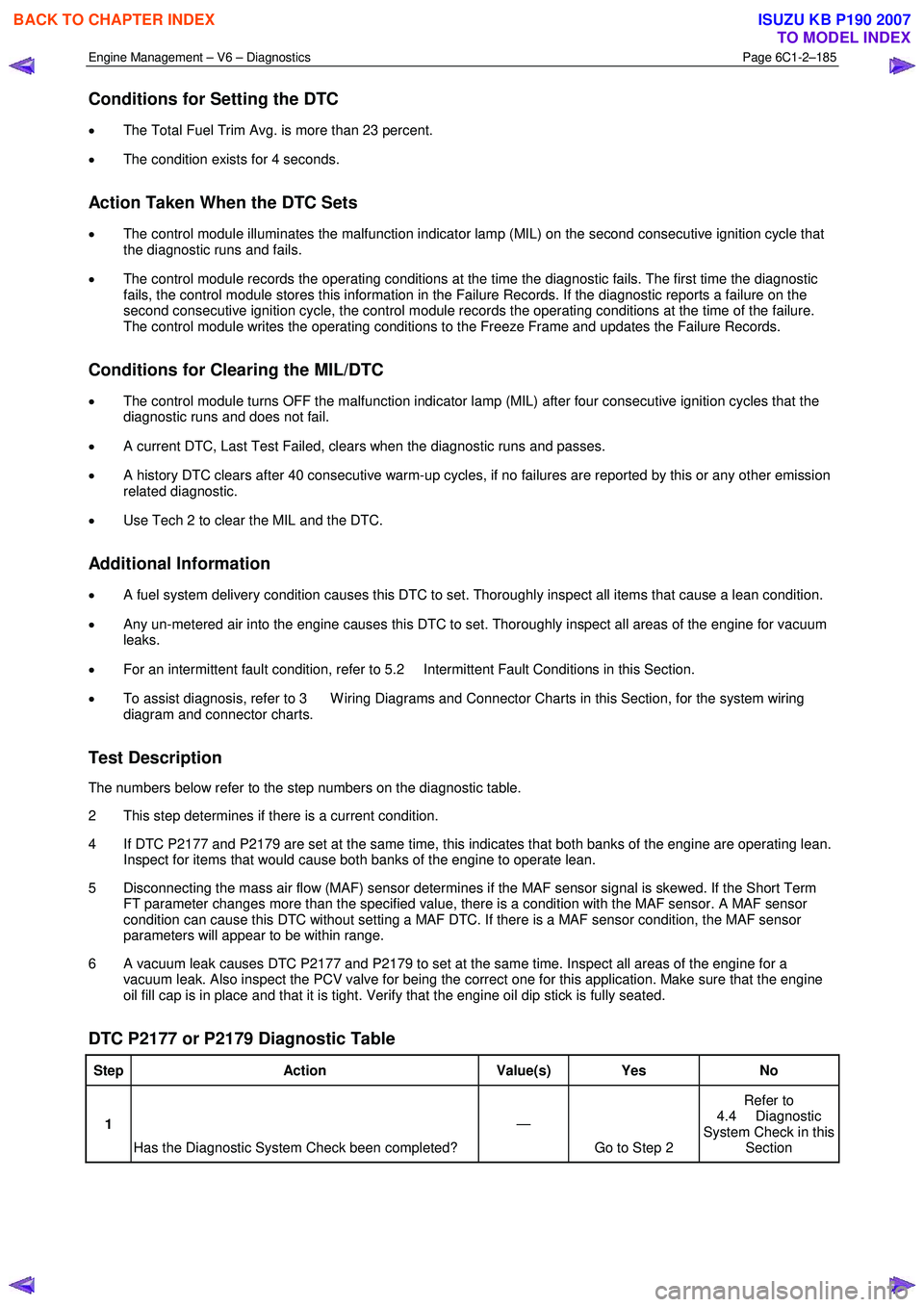
Engine Management – V6 – Diagnostics Page 6C1-2–185
Conditions for Setting the DTC
• The Total Fuel Trim Avg. is more than 23 percent.
• The condition exists for 4 seconds.
Action Taken When the DTC Sets
• The control module illuminates the malfunction indicator lamp (MIL) on the second consecutive ignition cycle that
the diagnostic runs and fails.
• The control module records the operating conditions at the time the diagnostic fails. The first time the diagnostic
fails, the control module stores this information in the Failure Records. If the diagnostic reports a failure on the
second consecutive ignition cycle, the control module records the operating conditions at the time of the failure.
The control module writes the operating conditions to the Freeze Frame and updates the Failure Records.
Conditions for Clearing the MIL/DTC
• The control module turns OFF the malfunction indicator lamp (MIL) after four consecutive ignition cycles that the
diagnostic runs and does not fail.
• A current DTC, Last Test Failed, clears when the diagnostic runs and passes.
• A history DTC clears after 40 consecutive warm-up cycles, if no failures are reported by this or any other emission
related diagnostic.
• Use Tech 2 to clear the MIL and the DTC.
Additional Information
• A fuel system delivery condition causes this DTC to set. Thoroughly inspect all items that cause a lean condition.
• Any un-metered air into the engine causes this DTC to set. Thoroughly inspect all areas of the engine for vacuum
leaks.
• For an intermittent fault condition, refer to 5.2 Intermittent Fault Conditions in this Section.
• To assist diagnosis, refer to 3 W iring Diagrams and Connector Charts in this Section, for the system wiring
diagram and connector charts.
Test Description
The numbers below refer to the step numbers on the diagnostic table.
2 This step determines if there is a current condition.
4 If DTC P2177 and P2179 are set at the same time, this indicates that both banks of the engine are operating lean. Inspect for items that would cause both banks of the engine to operate lean.
5 Disconnecting the mass air flow (MAF) sensor determines if the MAF sensor signal is skewed. If the Short Term FT parameter changes more than the specified value, there is a condition with the MAF sensor. A MAF sensor
condition can cause this DTC without setting a MAF DTC. If there is a MAF sensor condition, the MAF sensor
parameters will appear to be within range.
6 A vacuum leak causes DTC P2177 and P2179 to set at the same time. Inspect all areas of the engine for a vacuum leak. Also inspect the PCV valve for being the correct one for this application. Make sure that the engine
oil fill cap is in place and that it is tight. Verify that the engine oil dip stick is fully seated.
DTC P2177 or P2179 Diagnostic Table
Step Action Value(s) Yes No
1
Has the Diagnostic System Check been completed? —
Go to Step 2 Refer to
4.4 Diagnostic
System Check in this Section
BACK TO CHAPTER INDEX
TO MODEL INDEX
ISUZU KB P190 2007
Page 3465 of 6020
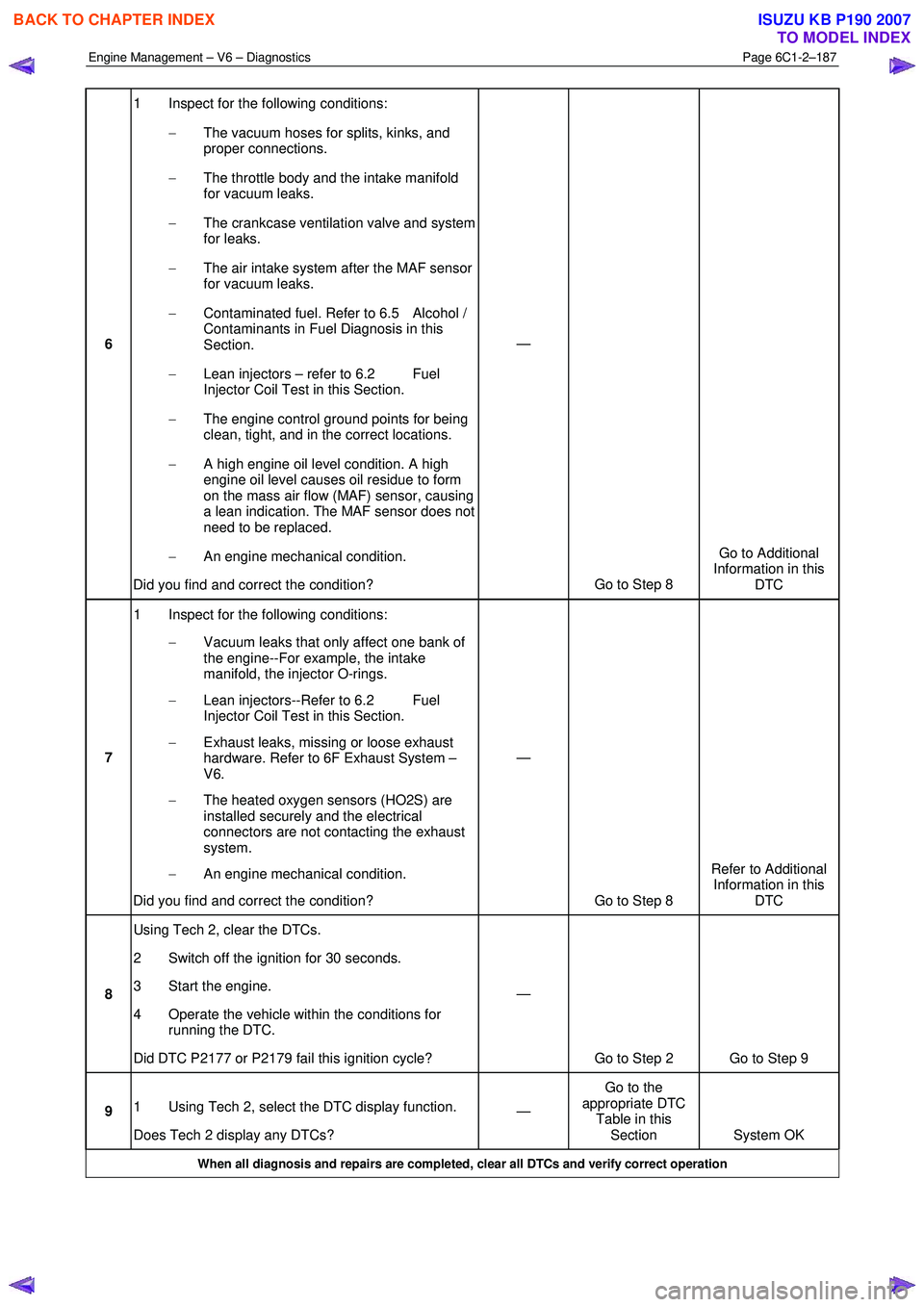
Engine Management – V6 – Diagnostics Page 6C1-2–187
6 1 Inspect for the following conditions:
− The vacuum hoses for splits, kinks, and
proper connections.
− The throttle body and the intake manifold
for vacuum leaks.
− The crankcase ventilation valve and system
for leaks.
− The air intake system after the MAF sensor
for vacuum leaks.
− Contaminated fuel. Refer to 6.5 Alcohol /
Contaminants in Fuel Diagnosis in this
Section.
− Lean injectors – refer to 6.2 Fuel
Injector Coil Test in this Section.
− The engine control ground points for being
clean, tight, and in the correct locations.
− A high engine oil level condition. A high
engine oil level causes oil residue to form
on the mass air flow (MAF) sensor, causing
a lean indication. The MAF sensor does not
need to be replaced.
− An engine mechanical condition.
Did you find and correct the condition? —
Go to Step 8 Go to Additional
Information in this DTC
7 1 Inspect for the following conditions:
− Vacuum leaks that only affect one bank of
the engine--For example, the intake
manifold, the injector O-rings.
− Lean injectors--Refer to 6.2 Fuel
Injector Coil Test in this Section.
− Exhaust leaks, missing or loose exhaust
hardware. Refer to 6F Exhaust System –
V6.
− The heated oxygen sensors (HO2S) are
installed securely and the electrical
connectors are not contacting the exhaust
system.
− An engine mechanical condition.
Did you find and correct the condition? —
Go to Step 8 Refer to Additional
Information in this DTC
8 Using Tech 2, clear the DTCs.
2 Switch off the ignition for 30 seconds.
3 Start the engine.
4 Operate the vehicle within the conditions for running the DTC.
Did DTC P2177 or P2179 fail this ignition cycle? —
Go to Step 2 Go to Step 9
9 1 Using Tech 2, select the DTC display function.
Does Tech 2 display any DTCs? —
Go to the
appropriate DTC Table in this Section System OK
When all diagnosis and repairs are completed, clear all DTCs and verify correct operation
BACK TO CHAPTER INDEX
TO MODEL INDEX
ISUZU KB P190 2007
Page 3468 of 6020
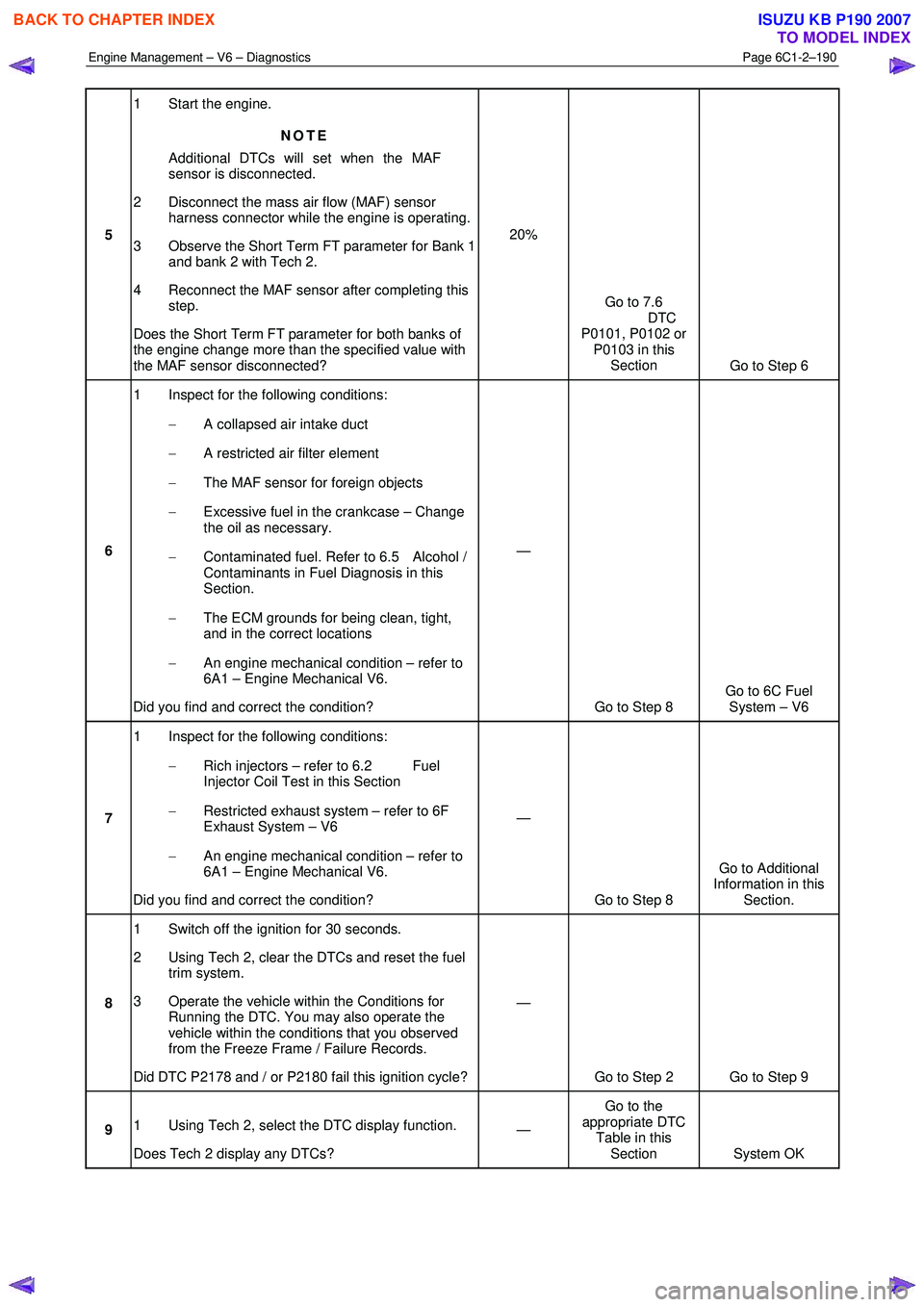
Engine Management – V6 – Diagnostics Page 6C1-2–190
5 1 Start the engine.
NOTE
Additional DTCs will set when the MAF
sensor is disconnected.
2 Disconnect the mass air flow (MAF) sensor harness connector while the engine is operating.
3 Observe the Short Term FT parameter for Bank 1 and bank 2 with Tech 2.
4 Reconnect the MAF sensor after completing this step.
Does the Short Term FT parameter for both banks of
the engine change more than the specified value with
the MAF sensor disconnected? 20%
Go to 7.6
DTC
P0101, P0102 or P0103 in this Section Go to Step 6
6 1 Inspect for the following conditions:
− A collapsed air intake duct
− A restricted air filter element
− The MAF sensor for foreign objects
− Excessive fuel in the crankcase – Change
the oil as necessary.
− Contaminated fuel. Refer to 6.5 Alcohol /
Contaminants in Fuel Diagnosis in this
Section.
− The ECM grounds for being clean, tight,
and in the correct locations
− An engine mechanical condition – refer to
6A1 – Engine Mechanical V6.
Did you find and correct the condition? —
Go to Step 8 Go to 6C Fuel
System – V6
7 1 Inspect for the following conditions:
− Rich injectors – refer to 6.2 Fuel
Injector Coil Test in this Section
− Restricted exhaust system – refer to 6F
Exhaust System – V6
− An engine mechanical condition – refer to
6A1 – Engine Mechanical V6.
Did you find and correct the condition? —
Go to Step 8 Go to Additional
Information in this Section.
8 1 Switch off the ignition for 30 seconds.
2 Using Tech 2, clear the DTCs and reset the fuel trim system.
3 Operate the vehicle within the Conditions for Running the DTC. You may also operate the
vehicle within the conditions that you observed
from the Freeze Frame / Failure Records.
Did DTC P2178 and / or P2180 fail this ignition cycle? —
Go to Step 2 Go to Step 9
9 1 Using Tech 2, select the DTC display function.
Does Tech 2 display any DTCs? —
Go to the
appropriate DTC Table in this Section System OK
BACK TO CHAPTER INDEX
TO MODEL INDEX
ISUZU KB P190 2007